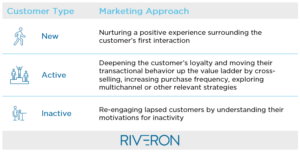Data-Driven Approaches to Restoring the Retailer-Consumer Balance
Many organizations today are reimagining their decision-making approaches by taking advantage of advancements in analytics technology. Advanced digital platforms—paired with well-engineered data platforms—will be an important investment to adequately understand evolving consumer behaviors, particularly in the retail sector. Retailers can use data analytics tools and enriched datasets to stay ahead of consumer trends, which remains a key challenge as dynamic shifts are underway.
Identifying customers by stages of engagement
While it is commonplace for consumers to offer identification in exchange for rewards from retailers, most retail companies could make better use of this data with structures that may already be in place. Retail organizations can use data from their “loyalty” or “member” programs to expand their knowledge of core customers and track changes in consumer behaviors. Best-in-class retail organizations approach this by establishing a baseline view of their customers using recent transaction history. Any purchase under a loyalty program assigns a unique identification number of the customer that allows the retailer to aggregate a customer’s transaction history. Because the consumer is identified, businesses can then apply logic to determine which customers are new, active, and inactive. This helps inform marketing tactics related to customers’ next interactions.

While the data logic that defines these categories may not be highly technical, it can require significant processing as the customer base grows (and, over time, each transaction must be aggregated underneath a customer identification number). By investing in data-driven enablers such as infrastructure, architecture, and analytical capabilities, companies can more efficiently capture the transactional events of the customer’s purchase history. By pairing activity metrics with historical trends, retailers can then use this data as a foundation for data-led customer engagement.
Understanding transactional patterns and other relevant behavior of consumers
Within retail, there has been a dramatic digital response to online demand accelerated by the pandemic. While “new normal” patterns emerge, business leaders will need to understand if this shift of demand online will resume by continuing to engage with the company’s loyalty data. Leaders must also understand whether their traditional brick-and-mortar business should be approached differently and if current events have caused a lasting change. As customer demands and storylines evolve —as with recent changes accelerated by the pandemic— teams should identify healthy and unhealthy changes in customer behavior by further subdividing the new and active customer groups into meaningful subgroupings of transactional data. Retailers should look to develop analytical insights and tracking mechanisms that align with the strategic model and promote improved buying behavior. Here, the most relevant transactional reporting elements can be tailored across loyalty tiers, the value ladder, the customer journey, and the product mix.

Effective customer analytics typically requires tracking and organizing customer data at a significant scale. As such, there is little use for traditional desktop applications when analyzing consumer spend behavior. So, companies need to think through and rationalize their data pipeline of customer events across many elements—from the point of sale to data storing, blending, transforming, and reporting of consumer activity. Consumers are more powerful in today’s marketplace, so retailers’ customer analytics and reporting must be equally as smart, focused, and efficient to allow quickly adapt to any changing preferences.
Analyzing consumer characteristics, preferences, and segments
Detailed knowledge of customers is best obtained through the information exchanged when signing up for a retailer’s loyalty rewards program. The exchange typically provides information on the customer’s name, email, phone number, billing/shipping address, start dates, and buying preferences. It also indirectly provides access to external content that provides more complex ways of analyzing and understanding customers. With the help of digital tools and platforms, retailers can better use this information to organize performance data and append external datasets, which enriches an understanding of customers’ transactional patterns. Retail data analysts can take the name and address of the customer from the loyalty program and join third-party datasets (e.g., credit reports, geolocators, etc.), which helps maximize engagement in the context of increasing customer loyalty, retention, and value.
Retailers can use external datasets in various ways. Examples include:
Credit agencies might provide valuable information on customer demographics, property characteristics, socio-economic factors, and relevant financial measures or credit history.
Mapmakers might provide data that helps us evaluate the distance customers are driving to a retail store, which can also inform trade area development.
Retail or consumer data and market measurement firms might provide performance data, insights on consumer behavior, or benchmarking metrics.
In the past, retailers relied primarily on internal data, but modern-era analytics allow companies to expand their possibilities. Now, third-party datasets are available and accessible, which enables better consumer profiling through more advanced analytical techniques and platforms. This comprehensive view defines ideal consumer segments and informs tactics — helping retailers increase site performance, improve product assortment, or move customers up the value ladder.
Adopting a test-and-learn environment to adapt quickly to changing consumer preferences
Once the customer populations have been counted, their buying behavior tracked, and profiles have been created by enriching the data with external datasets, retailers start to develop a prescriptive view of their ideal customer. This view can be developed through levers such as assortment changes and marketing campaigns. Analytic teams can conduct transformational analysis by experimenting with growth initiatives through a test-and-learn environment.
There are many possible examples of test-and-learn scenarios, such as:
For in-store interactions (given the dramatic and likely permanent decrease in traditional foot traffic), a test might involve refocusing store formats toward experiential designs that engage a younger audience.
For online interactions, a test could involve ramping up e-commerce acquisitions by investing in virtual interactions and experiential content online. In such cases, a retailer could accelerate an intentional move to push customers online, ultimately reducing the company’s physical footprint.
Retailers analyze whether test environments such as experiential stores or online experiences boost customer traffic and loyalty. Analytic platforms can serve the function of benchmarking customer and transaction activity before and after an event, measuring effects relative to a control group. An analysis of traffic, transactions, and margins can determine if the strategy creates lift for the business and calls for a larger rollout.
Testing environments should encourage the acceptance of failed experiments, allowing each business to learn and make revisions until hypotheses indicate value. These complex, small-scale, and rapid experiments are best managed from beginning to end through advanced analytic platforms that monitor events and help differentiate causation from correlation.
A well-planned approach to consumer intelligence can help retailers realize new possibilities by balancing the relationship between businesses and consumers. Now that customer data is more readily available, businesses need efficient solutions to organize and process that data and stay ahead of changing consumer behaviors. A retailer’s competitive edge hinges on a strong understanding of customers, and enabling a business to quickly ingest and decipher consumer intelligence requires investment in a useful technological environment.



